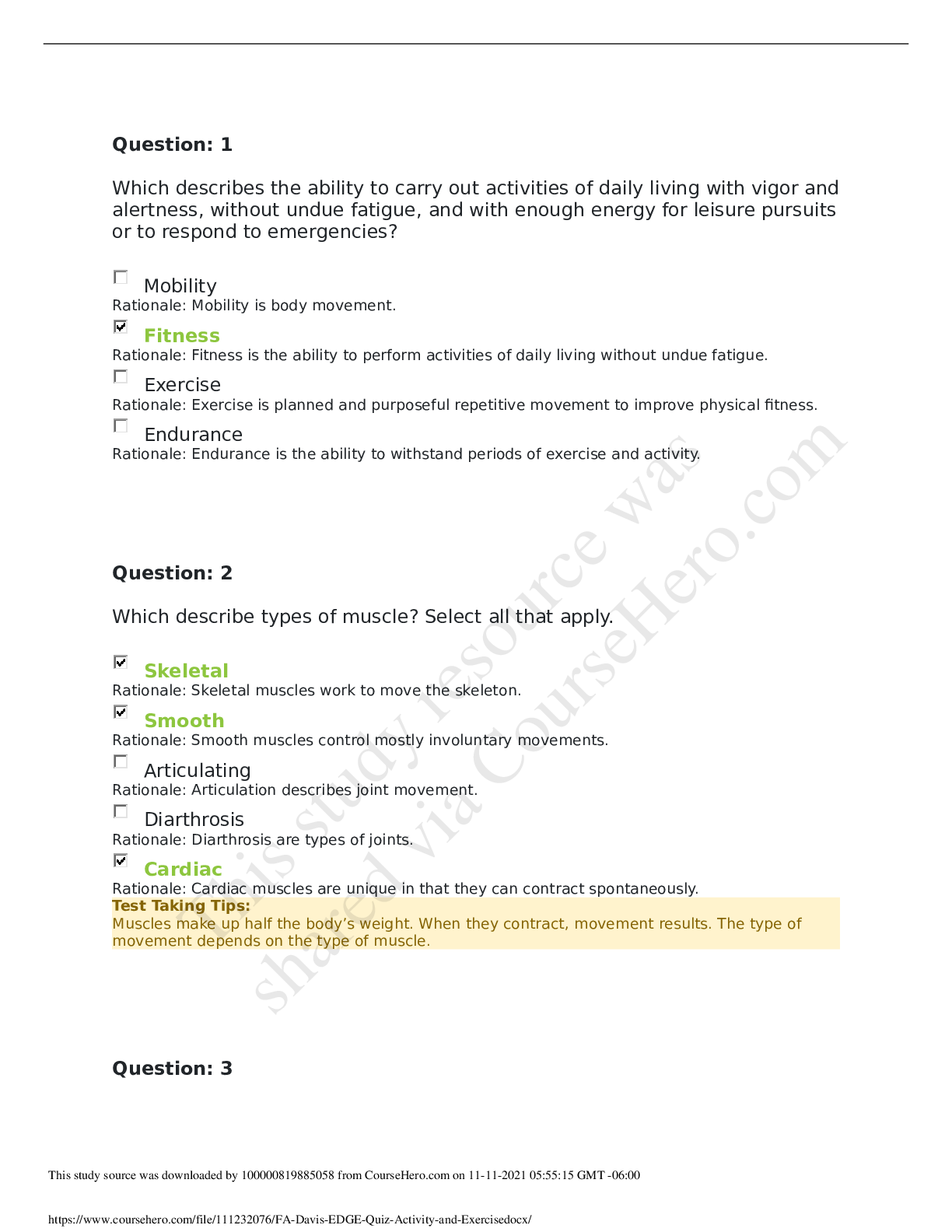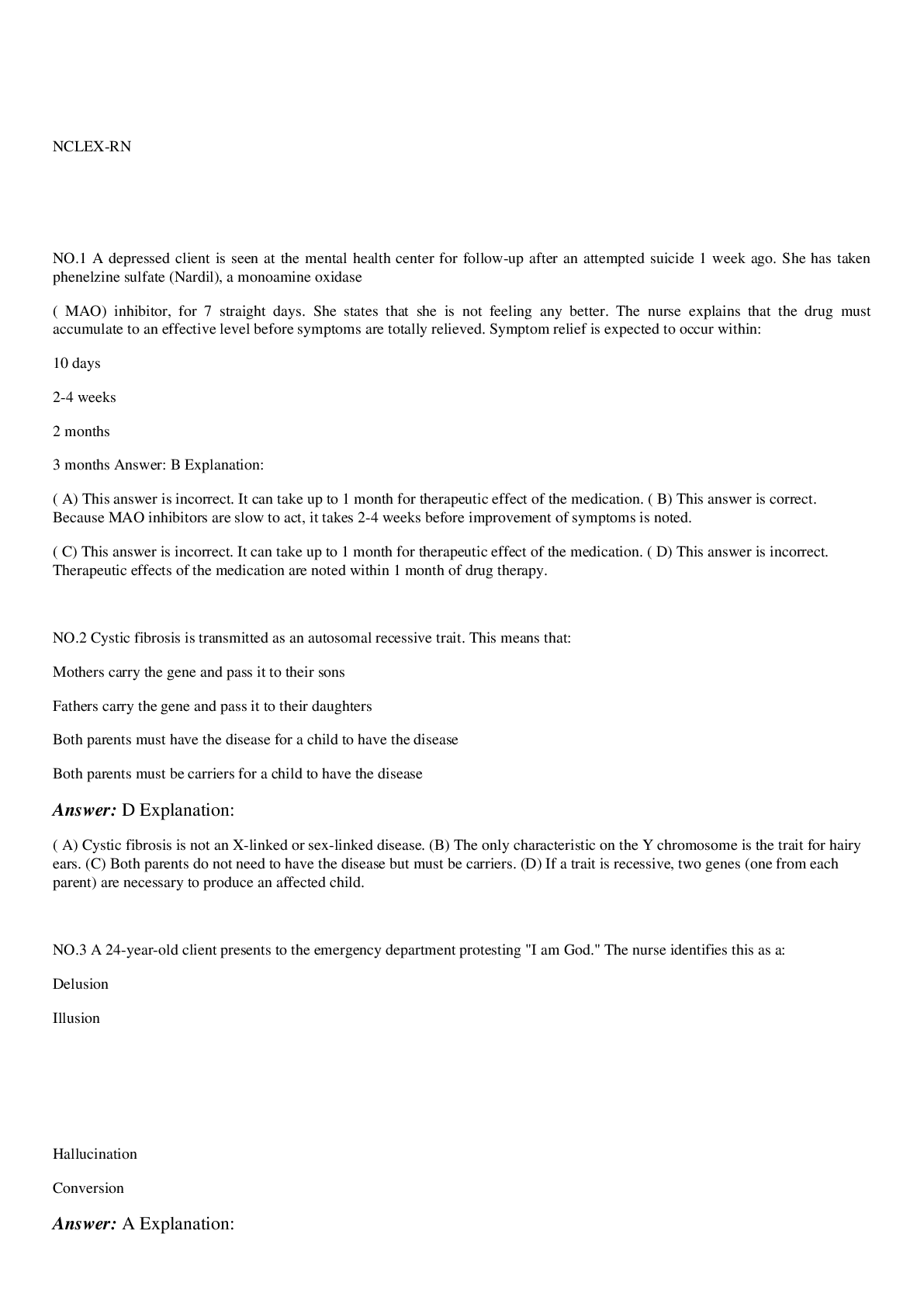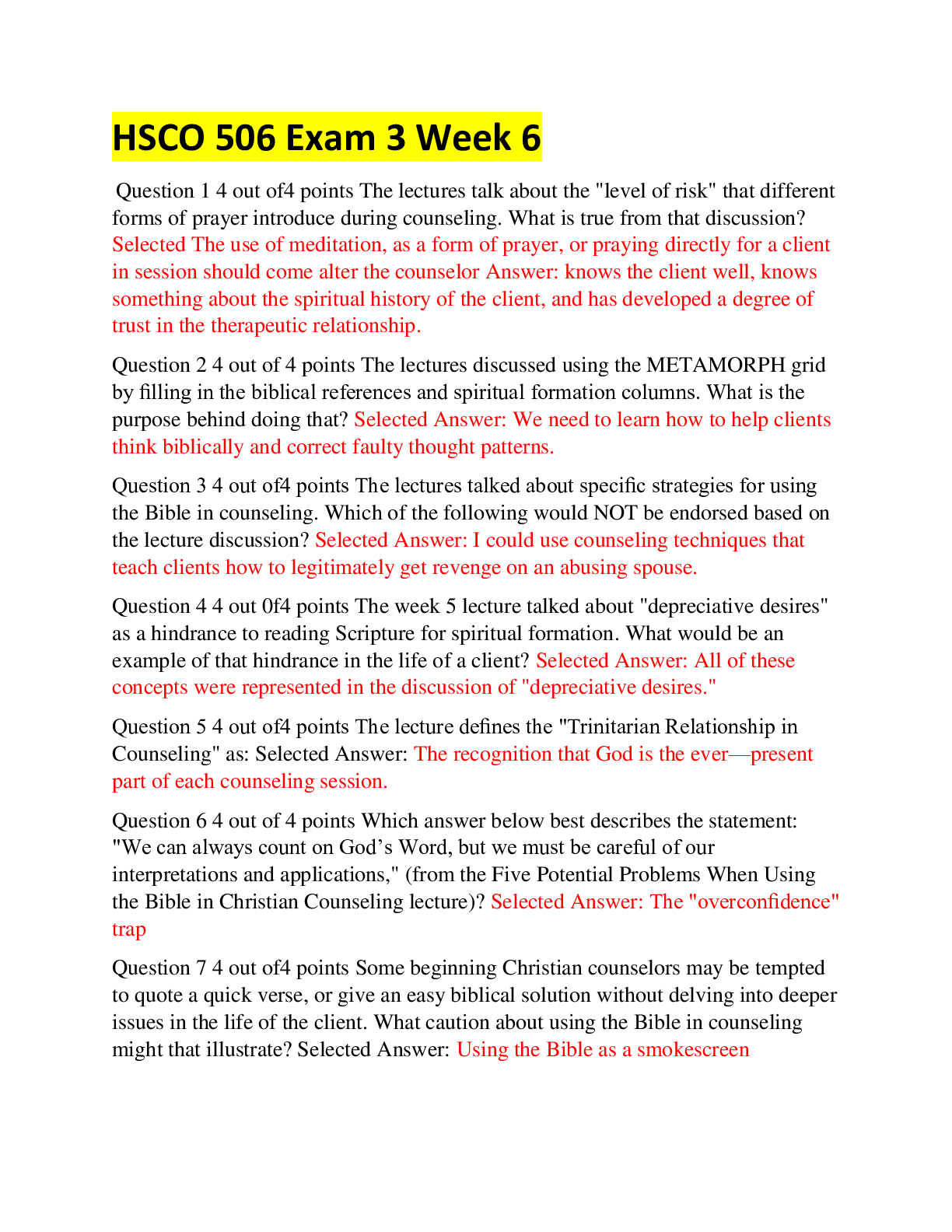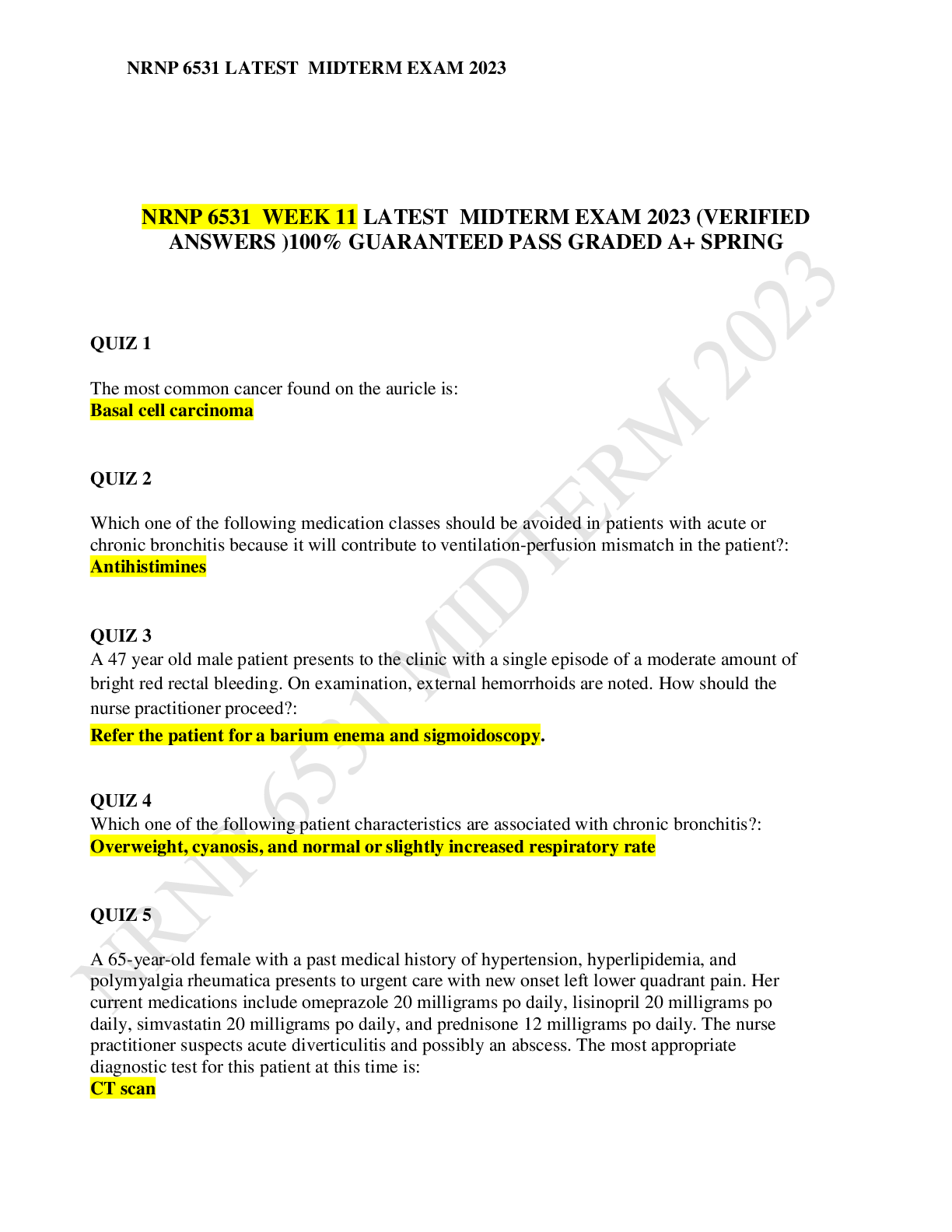*NURSING > EXAM > NUR 112 FA Davis EDGE Quiz - Activity and Exercise (With Verified Answers )100% Correct (All)
NUR 112 FA Davis EDGE Quiz - Activity and Exercise (With Verified Answers )100% Correct
Document Content and Description Below
Question: 1 Which describes the ability to carry out activities of daily living with vigor and alertness, without undue fatigue, and with enough energy for leisure pursuits or to respond to emergen... cies? Mobility Rationale: Mobility is body movement. Fitness Rationale: Fitness is the ability to perform activities of daily living without undue fatigue. Exercise Rationale: Exercise is planned and purposeful repetitive movement to improve physical fitness. Endurance Rationale: Endurance is the ability to withstand periods of exercise and activity. Question: 2 Which describe types of muscle? Select all that apply. Skeletal Rationale: Skeletal muscles work to move the skeleton. Smooth Rationale: Smooth muscles control mostly involuntary movements. Articulating Rationale: Articulation describes joint movement. Diarthrosis Rationale: Diarthrosis are types of joints. Cardiac Rationale: Cardiac muscles are unique in that they can contract spontaneously. Question: 3 Which describes the attachment of a muscle to a more stable bone? Point of origin Rationale: The point of origin is where a muscle is attached to a stable bone. Point of insertion Rationale: The point of insertion is the attachment of a muscle to a moveable bone. Articulation Rationale: Articulation describes the movement of joints. Synovial point Rationale: Synovial joints are freely moving joints. Question: 4 If a person makes a conscious decision to bend the elbow, which nervous system is applied? Autonomic nervous system Rationale: The autonomic nervous system innervates involuntary or smooth muscle. Somatic nervous system Rationale: Skeletal muscle is activated by the somatic nervous system. Reflex mechanism Rationale: A reflex mechanism is a nerve reaction to external stimulation. Synovial movement Rationale: Synovial movement describes the movement of joints. Question: 5 Which structures are involved in physical coordination? Select all that apply. Cerebral cortex Rationale: The cerebral cortex initiates voluntary movement. Frontal lobe Rationale: The frontal lobe is a sensory receiver and has cognitive function. Spinal cord Rationale: The spinal cord is a central receiver for nervous stimulation, but it is not involved in coordination. Cerebellum Rationale: The cerebellum coordinates movement and is responsible for posture, movement, and position sense. Basal ganglia Rationale: Basal ganglia assist with coordination of movement. Question: 6 Weight training with free weights is an example of which type of exercise? Isometric Rationale: Isometric exercise is muscle contraction without motion. Isotonic Rationale: Isotonic exercise is a movement of a joint from muscle contraction. Isokinetic Rationale: Isokinetic exercise is the use of specialized equipment to provide resistance to movement. Aerobic Rationale: Aerobic exercise is when the oxygen taken into the body meets or exceeds oxygen demand. Question: 7 Which is an appropriate nursing diagnosis for a client who has had a stroke and has left-sided hemiparesis? Impaired physical mobility Rationale: This is an appropriate nursing diagnosis for a client who has had surgery to repair a fractured femur. Sedentary lifestyle Rationale: This is an appropriate nursing diagnosis for an obese client who does not exercise and receives assistance for activities of daily living. Risk for disuse syndrome Rationale: This is an appropriate nursing diagnosis for a client who has had a stroke and has left- sided hemiparesis. Risk for injury Rationale: This is an appropriate nursing diagnosis for a confused client who has difficulty ambulating but forgets to call for assistance. Question: 8 Which is an inflammatory response to high levels of uric acid in the blood, resulting in severe pain and limited activity levels? Ankylosing spondylitis Rationale: Ankylosing spondylitis is a chronic inflammatory joint disease that results in stiffening of joints. Rheumatoid arthritis Rationale: Rheumatoid arthritis is a chronic autoimmune disease that results in inflammation of the joints. Gout Rationale: Gout produces painful joints and severely limits activity during flare-ups. Osteoarthritis Rationale: Osteoarthritis is the loss of articular cartilage in the joints, resulting in stiffness and immobility of joints. Question: 9 Which describes the stretching of a ligament that causes the ligament to tear? Sprain Rationale: A sprain is a torn ligament from overstretching of the ligament. Strain Rationale: A strain is an injury to a muscle caused by overuse or overstress. Fracture Rationale: A fracture is a broken bone. Degeneration Rationale: Degeneration is a loss of bone or muscle mass. Question: 10 A nurse is assisting a client to a standing position. The client requires frequent breaks and is unable to catch his or her breath. After standing for a few seconds, the client states he or she is exhausted and needs to lie down again. Which is an appropriate priority nursing diagnosis for this client? Impaired physical mobility Rationale: Impaired physical mobility is applicable to an actual inability to move, rather than exhaustion as a result of moving. Activity intolerance Rationale: A client who becomes fatigued easily and needs frequent breaks when moving has activity intolerance. Risk for injury Rationale: The client may have a risk for injury, but this is due to the fatigue from moving. Risk for disuse syndrome Rationale: The client may have a risk for disuse of part or all of their body, but this is not the primary problem. Question: 11 Which are guidelines for good body mechanics? Select all that apply. Wide base of support Rationale: Feet placed about shoulder width apart provides a sturdy base of support. Head facing down Rationale: The head should be held upright and straight for optimum posture. Abdominal muscles tight Rationale: Abdominal muscles pulled in tight promote straight posture. Shoulders dropped forward Rationale: Shoulders should be held back to promote alignment of the spine. Chest high Rationale: Standing with the chest high promotes good body mechanics and spinal support. Question: 12 Which is the most prevalent type of degenerative disease that can severely limit a person’s ability to perform physical activity? Osteoarthritis Rationale: Osteoarthritis is a deterioration of articular cartilage in the joints. Rheumatoid arthritis Rationale: Rheumatoid arthritis is an autoimmune disease that causes inflammation of joints. Gout Rationale: Gout is a buildup of uric acid in the blood, resulting in a painful, inflammatory process Osteomyelitis Rationale: Osteomyelitis is a bone infection that may occur after trauma or surgery. Question: 13 Which position is described as the client lying in a semi-recumbent position, with the head of the bed elevated to 30 degrees? Fowler’s position Rationale: Fowler’s position is the client sitting almost upright, with the head of bed elevated to 45 to 90 degrees. Semi-Fowler’s position Rationale: Semi-Fowler’s position involves the client lying on his or her back with the head of the bed elevated to 30 degrees. Prone position Rationale: Prone position is the client lying on his or her stomach. Lateral position Rationale: Lateral position is a side-lying position. Question: 14 Which would be the most appropriate way of moving a client who is very obese and immobile? Trapeze Rationale: A client who is very obese has a risk of injury when using the trapeze. Transfer board Rationale: A transfer board may not be sufficient for moving a very obese client, and it may lead to caregiver injury. Mechanical lift Rationale: A mechanical lift utilizes a fabric swing to lift the client and minimizes risk of injury to the client and caregiver. Transfer belt Rationale: A transfer belt is used only if the client is able to assist with standing. • • • • [Show More]
Last updated: 2 years ago
Preview 1 out of 8 pages

Buy this document to get the full access instantly
Instant Download Access after purchase
Buy NowInstant download
We Accept:

Reviews( 0 )
$12.00
Can't find what you want? Try our AI powered Search
Document information
Connected school, study & course
About the document
Uploaded On
Nov 11, 2021
Number of pages
8
Written in
Additional information
This document has been written for:
Uploaded
Nov 11, 2021
Downloads
0
Views
79

.png)







.png)





